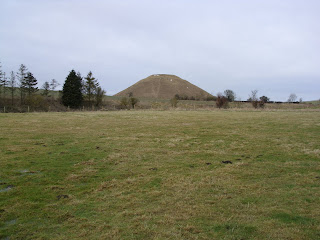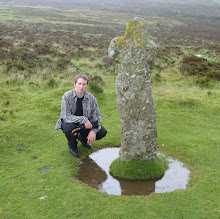

This weekend I finally managed to visit Highgate Cemetery in London. The journey took us on the London Underground. There are many reports of ghosts on the underground, although we didn't see anything.
It was a bright sunny day, and we walked up Highgate Hill. We didn't realise how steep this hill - which is really a busy thoroughfare for traffic - actually is. However when we reached the top we cut through the delightful Waterlow Park. This is like a green oasis in London. The park is quite large and we saw squirrels, ducks and geese.
The walk through the park leads into Highgate Cemetery. The entrance to the cemetery is an imposing gothic building.
 Large cemeteries such as this are renowned for their flore and fauna, and the first thing I noticed as the guided tour began was the abundance of snowdrops carpeting the ground, and growing up between cracks in the broken slabs of stone. The pale winter sun shone thinly through the trees.
Large cemeteries such as this are renowned for their flore and fauna, and the first thing I noticed as the guided tour began was the abundance of snowdrops carpeting the ground, and growing up between cracks in the broken slabs of stone. The pale winter sun shone thinly through the trees.Despite the silence and solemnity of the funereal architecture, I felt there was a sense of rebirth and growth which is to do with the early signs of spring.



Our tour guide explained about the history and architecture. Many of the monuments are protected by English Heritage for their architectural and artistic merit.
This is the grave of a young girl, especially poignant because of the chair from which she seems to have suddenly got up and left:

Many of the monuments are overgrown, which makes them very atmospheric and gives them a natural beauty. The Western cemetery was closed in the 1970s after spates of vandalism, and we were some of the first people to have visited it for 30 years.
 Our tour guide showed us his own family vault where he said he would like to be buried.
Our tour guide showed us his own family vault where he said he would like to be buried.
Although most of the graves are old, we found a more recent one, and when we asked who it belonged to, were told it was that of the murdered Russian spy Alexander Litvienko.
The most curious structure in the cemetery is the Egyptian Avenue. This reflects the Victorian's fascination with Ancient Egyptian History and and architecture. Unfortunately none of the familes who have relatives buried here have replied to requests to maintain them, so like most of the other graves, they have fallen into disrepair. Long tresses of ivy overhang the tops of the entrance to the Egyptian Avenue, which leads up into the Lebanon Circle.



There are stone eagles on the top of the Egyptian Avenue which represent guardianship and protection.

 We then reached the Circle of Lebanon, which is topped by magnificent Cedar of Lebanon tree. This pre-dates the cemetery itself, and grows out of the circular structure.
We then reached the Circle of Lebanon, which is topped by magnificent Cedar of Lebanon tree. This pre-dates the cemetery itself, and grows out of the circular structure.

 I was impressed by this huge gothic entrance to the catacombs, although we were not allowed to enter them.
I was impressed by this huge gothic entrance to the catacombs, although we were not allowed to enter them.At this point we peeped through the window of the largest vault in the cemetery, of a Victorian businessman called Beers. The vault is sealed and apparently has a solid gold ceiling, and a gold effigy of a young woman. I noticed lots of ornate decoration while peering through the glass.

One of the more unusual graves has a lion sat on top, this lion was apparently a tame lion which was popular with the public. There are many stone animals, the grave of a famous bare knuckle boxer also has his pet dog.

There is some ornate metal work throughout the cemetery and in places there are traces of the original paintwork, which is described as "racing green". English Heritage hopes to restore some of the metalwork to this original colour.

They have also created new metalwork in an attempt to restore some of the vaults to their original condition.
 Parts of the cemetery are so overgrown and shaded by trees, they seem to be in almost perputual darkness, as can be seen from the photograph I took of the grave of Frederick Warne.
Parts of the cemetery are so overgrown and shaded by trees, they seem to be in almost perputual darkness, as can be seen from the photograph I took of the grave of Frederick Warne.Mr Frederick Warne was the original publisher of Beatrix Potter books.



Another magnificent tree in the cemetery is this horse chestnut

Having finished the West Cemetery tour, I bought the English Heritage book and my friend made a donation towards the upkeep of the cemetery, which is run by a charity.
We then went to visit the East Cemetery, the second half, which turned out to be less impressive atmospherically although it still has many graves of famous people. The most popular of which seems to be that of philisopher Karl Marx. He apparently requested a simple headstone, and had this until about 50 years ago when the Communist Party had this new memorial erected, which some have described as tasteless.

I was disappointed that I did not have time to find the graves of Elizabeth Siddell or the Pre-Raphaelites. I may go back in a different season to attempt this. However in the Eastern Cemetery I was very impressed with some of the angels. I think the angels of Highgate were for me the highlight, as they have such melancholy beauty.

 We also saw a robin perched on one of the headstones which seemed very picturesque. As we left the cemetery through Waterlow Park, we saw more squirrels. All in all it was a very eccentric place to visit, yet rich in historical and aesthetic value (not to mention all the flora and fauna..).
We also saw a robin perched on one of the headstones which seemed very picturesque. As we left the cemetery through Waterlow Park, we saw more squirrels. All in all it was a very eccentric place to visit, yet rich in historical and aesthetic value (not to mention all the flora and fauna..).

























